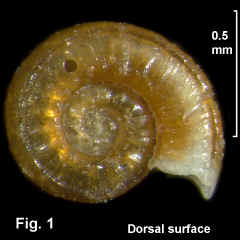|
< Previous family introduction |
|
|||||
 |
Family Omalogyridae Omalogyrids
|
|||||
|
The Omalogyridae is a small family of minute, almost planar shells which are some of the smallest molluscs known. They are usually less than 2 mm in diameter, but one NSW species is about 0.6 mm They have thin reddish or brown translucent shells. They occur worldwide in the lower intertidal and subtidal zones, living on or in association with algae. Omalogyrids feed on the cell contents of alga such as Ulva, puncturing the cells with radular teeth and sucking out the contents. The NSW species have been found abundantly on Ulva intertidally, and on other algae. They have also been reported from under stones, where they are probably feeding on minute algae. Omalogyrids are hermaphrodite with separate male and female gonads. The European species Omalogyra atomus, which is the most closely studied species, is protandrous, having separate ovary and testis, being at first male then changing to female. Egg capsules are attached to algal fronds. There are only three species of omalogyrids known from NSW, all described by Charles Laseron in 1954. He placed them in the family Liotiidae, where they remained until Ponder & de Keyzer (1998) investigated the animal's external morphology and consequently transferred them to the Omalogyridae. Family References Laseron, C. 1954. Revision of the Liotiidae of New South Wales. The Australian Zoologist 1-12:1-25. Ponder, W.F. & de Keyzer, R.G. 1998. Superfamily Omalogyroidea Pp. 864-865 in Beesley, P.L., Ross, G.J.B. & Wells, A. (eds) Mollusca: The Southern Synthesis. Fauna of Australia Vol. 5. CSIRO Publishing: Melbourne, part B viii 565-1234 pp. Coverage The three named species from NSW are detailed here, but it is likely that there are further undescribed species. Identification Notes The shells of this family are recognised by
Families that have similar shells are:
|